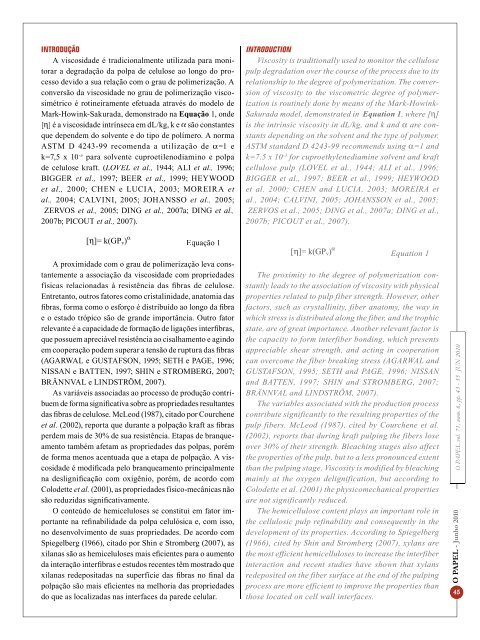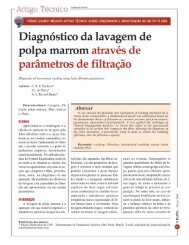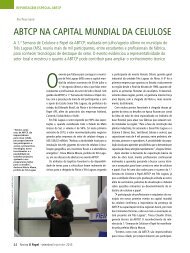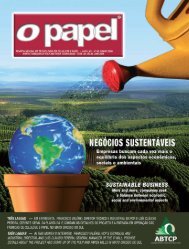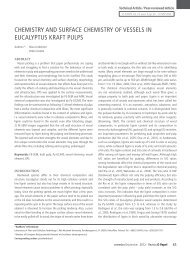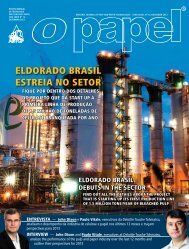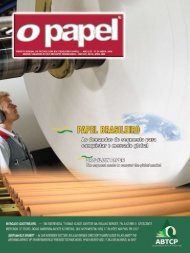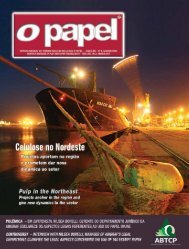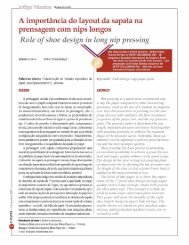Brasil na PulPaper - Revista O Papel
Brasil na PulPaper - Revista O Papel
Brasil na PulPaper - Revista O Papel
Create successful ePaper yourself
Turn your PDF publications into a flip-book with our unique Google optimized e-Paper software.
INTRODUÇÃOA viscosidade é tradicio<strong>na</strong>lmente utilizada para monitorara degradação da polpa de celulose ao longo do processodevido a sua relação com o grau de polimerização. Aconversão da viscosidade no grau de polimerização viscosimétricoé rotineiramente efetuada através do modelo deMark-Howink-Sakurada, demonstrado <strong>na</strong> Equação 1, onde[h] é a viscosidade intrínseca em dL/kg, k e a são constantesque dependem do solvente e do tipo de polímero. A normaASTM D 4243-99 recomenda a utilização de a=1 ek=7,5 x 10 -3 para solvente cuproetilenodiamino e polpade celulose kraft. (LOVEL et al., 1944; ALI et al., 1996;BIGGER et al., 1997; BEER et al., 1999; HEYWOODet al., 2000; CHEN e LUCIA, 2003; MOREIRA etal., 2004; CALVINI, 2005; JOHANSSO et al., 2005;ZERVOS et al., 2005; DING et al., 2007a; DING et al.,2007b; PICOUT et al., 2007).INTRODUCTIONViscosity is traditio<strong>na</strong>lly used to monitor the cellulosepulp degradation over the course of the process due to itsrelationship to the degree of polymerization. The conversionof viscosity to the viscometric degree of polymerizationis routinely done by means of the Mark-Howink-Sakurada model, demonstrated in Equation 1, where [h]is the intrinsic viscosity in dL/kg, and k and a are constantsdepending on the solvent and the type of polymer.ASTM standard D 4243-99 recommends using a=1 andk=7.5 x 10 -3 for cuproethylenediamine solvent and kraftcellulose pulp (LOVEL et al., 1944; ALI et al., 1996;BIGGER et al., 1997; BEER et al., 1999; HEYWOODet al. 2000; CHEN and LUCIA, 2003; MOREIRA etal., 2004; CALVINI, 2005; JOHANSSON et al., 2005;ZERVOS et al., 2005; DING et al., 2007a; DING et al.,2007b; PICOUT et al., 2007).Equação 1A proximidade com o grau de polimerização leva constantementea associação da viscosidade com propriedadesfísicas relacio<strong>na</strong>das à resistência das fibras de celulose.Entretanto, outros fatores como cristalinidade, a<strong>na</strong>tomia dasfibras, forma como o esforço é distribuído ao longo da fibrae o estado trópico são de grande importância. Outro fatorrelevante é a capacidade de formação de ligações interfibras,que possuem apreciável resistência ao cisalhamento e agindoem cooperação podem superar a tensão de ruptura das fibras(AGARWAL e GUSTAFSON, 1995; SETH e PAGE, 1996;NISSAN e BATTEN, 1997; SHIN e STROMBERG, 2007;BRÄNNVAL e LINDSTRÖM, 2007).As variáveis associadas ao processo de produção contribuemde forma significativa sobre as propriedades resultantesdas fibras de celulose. McLeod (1987), citado por Courcheneet al. (2002), reporta que durante a polpação kraft as fibrasperdem mais de 30% de sua resistência. Etapas de branqueamentotambém afetam as propriedades das polpas, porémde forma menos acentuada que a etapa de polpação. A viscosidadeé modificada pelo branqueamento principalmente<strong>na</strong> deslignificação com oxigênio, porém, de acordo comColodette et al. (2001), as propriedades físico-mecânicas nãosão reduzidas significativamente.O conteúdo de hemiceluloses se constitui em fator importante<strong>na</strong> refi<strong>na</strong>bilidade da polpa celulósica e, com isso,no desenvolvimento de suas propriedades. De acordo comSpiegelberg (1966), citado por Shin e Stromberg (2007), asxila<strong>na</strong>s são as hemiceluloses mais eficientes para o aumentoda interação interfibras e estudos recentes têm mostrado quexila<strong>na</strong>s redepositadas <strong>na</strong> superfície das fibras no fi<strong>na</strong>l dapolpação são mais eficientes <strong>na</strong> melhoria das propriedadesdo que as localizadas <strong>na</strong>s interfaces da parede celular.Equation 1The proximity to the degree of polymerization constantlyleads to the association of viscosity with physicalproperties related to pulp fiber strength. However, otherfactors, such as crystallinity, fiber a<strong>na</strong>tomy, the way inwhich stress is distributed along the fiber, and the trophicstate, are of great importance. Another relevant factor isthe capacity to form interfiber bonding, which presentsappreciable shear strength, and acting in cooperationcan overcome the fiber breaking stress (AGARWAL andGUSTAFSON, 1995; SETH and PAGE, 1996; NISSANand BATTEN, 1997; SHIN and STROMBERG, 2007;BRÄNNVAL and LINDSTRÖM, 2007).The variables associated with the production processcontribute significantly to the resulting properties of thepulp fibers. McLeod (1987), cited by Courchene et al.(2002), reports that during kraft pulping the fibers loseover 30% of their strength. Bleaching stages also affectthe properties of the pulp, but to a less pronounced extentthan the pulping stage. Viscosity is modified by bleachingmainly at the oxygen delignification, but according toColodette et al. (2001) the physicomechanical propertiesare not significantly reduced.The hemicellulose content plays an important role inthe cellulosic pulp refi<strong>na</strong>bility and consequently in thedevelopment of its properties. According to Spiegelberg(1966), cited by Shin and Stromberg (2007), xylans arethe most efficient hemicelluloses to increase the interfiberinteraction and recent studies have shown that xylansredeposited on the fiber surface at the end of the pulpingprocess are more efficient to improve the properties thanthose located on cell wall interfaces.O PAPEL - Junho 2010 O PAPEL vol. 71, num. 6, pp. 43 - 55 JUN 201045


